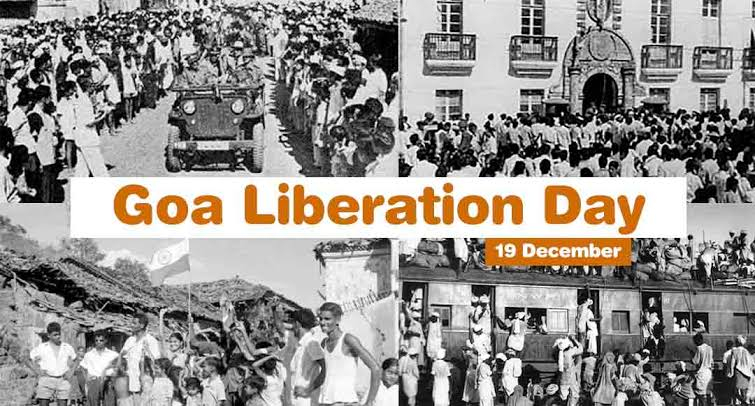
Krishna Menon, a close leader of Jawaharlal Nehru, lived abroad and was very active in India’s freedom struggle from there for a long time. Mr. Menon used to say that Goa is like a pimple on India’s face. often Mr. He used to tell Nehru that Goa ‘needs to be brought back’.
However, Mr. Goa. Nehru had a kind of ‘mental block’. He assured the Western countries that he would not try to take Goa by force.
But Mr. Krishna Menon. was able to convince Nehru that he could not be ambivalent about this Portuguese colony.
While criticizing the apartheid countries on the one hand, on the other hand, Jawaharlal Nehru was completely silent on the occupation of Goa by the Portuguese within India.
After all, efforts to peacefully remove the Portuguese from Goa failed, and Mr. Nehru gave a green signal to plan to liberate Goa by sending an army.
Valmiki Fellero, the author of the recently published book ‘Goa Liberation 1961 The Complete Story of Nationalism and Integration’, has written that the mobilization of Indian troops began on December 2, 1961. Agra, Hyderabad and the then Madras 50th Parachute Brigade were brought to Belagavi.
“Over 100 passenger trains from the north, west, and south of India were diverted to transport troops to Belagavi.” Besides passenger trains, several goods trains were also used to transport military equipment to Belagavi.
As a result, several textile mills in Ahmedabad had to close due to shortage of coal.”
India came to Goa from Portugal
Portugal also started preparing to face the Indian forces.
They sent a ship named ‘India’ to Goa LIberation to send the gold deposited in the ‘Banco Nacional Ultramarino’ and the wives and children of Portuguese citizens to Lisbon.
PN Khera in his book ‘Operation Vijay, The Liberation of Goa and Other Portuguese Colonies in India’ wrote, “On December 9, 1961, the Portuguese ship reached Murmugao. The ship started its return journey to Lisbon on December 12.
The ship had accommodation for 380 people, but about 700 women and children boarded the ship. There were so many passengers on that ship that some passengers had to sit on the toilet.
John Kenneth Galbraith, the US ambassador to India, met with Indian Prime Minister Jawaharlal Nehru several times in December to try to dissuade him from deciding on a military operation in Goa.
The day of the military operation in Goa Liberation was fixed on 14th December. But later it was postponed by two days to December 16.
Just one day before, on 15th December Mr. Galbraith Mr. Nehru and his finance minister met Morarji Desai.
Adela Gaitonde wrote in her book ‘In Search of Tomorrow’, “Morarji was against violence in Goa, as he personally favored non-violence as a solution to colonial problems.”
“So confident were the Portuguese in the diplomatic efforts of the United States that on the night of December 16, the Portuguese governor-general and the commander-in-chief of his army attended a wedding dinner for a friend’s daughter.”
Ambassador of the United States Mr. Met Nehru again on the 17th and proposed that India suspend military operations against Goa for six months.
Mr. Krishna Menon was present at that meeting. Nehru and Mr. told Galbraith that it was ‘too late now’. Indian troops have entered Goa and will not go back.
However, many years later Krishna Menon admitted in an interview that he had not given the correct information at that meeting, as the Indian Army had not yet crossed the Goa border.
That night, Krishna Menon arrived at the Goa border and inspected the Indian forces.
Mr. Indian Army entered Goa before Menon informed Jawaharlal Nehru of the planned military operation.
nominal resistance
The Indian Army crossed the Goa border at midnight on 17-18 December.
The Times of India newspaper published a ‘banner headline’ on 19 December, which in Bengali read ‘Finally our army has entered Goa, Daman, and Diu’.
The Indian Army encountered little resistance in entering Goa. The occupation of Goa was entrusted to the 17th Infantry Division under the command of Major General Candeth.
Historian Ramachandra Guha wrote in his book ‘India After Gandhi’, “On the morning of 18 December, Indian troops entered Goa from Sawantwadi in the north, Karwar in the south, and Belgaum in the east.”
“In the meantime, Indian planes dropped leaflets over Goa urging residents to remain calm and courageous.”The leaflets said, ‘Rejoice for freedom and strengthen it.'”
“Indian forces surrounded the capital city of Panaji by the evening of 18 December. It was the locals who warned the Indian forces about the landmines where the Portuguese had laid them.”
Within 36 hours of the start of the operation, the Portuguese Governor General signed the document of unconditional surrender.
When the soldiers of the Punjab Regiment entered Panaji, they found the Portuguese officers and their soldiers clad only in underwear.
When asked why, they were told that the Indian soldiers were so cruel that if they recognized a Portuguese soldier by his uniform, they would shoot him instantly.